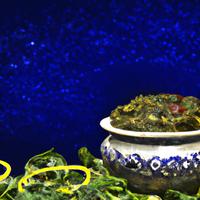
1 serving (200 grams) contains 150 calories, 5.0 grams of protein, 10.0 grams of fat, and 10.0 grams of carbohydrates.

Log this food in SnapCalorie

Nutrition Information
Calories |
176.5 | ||
|---|---|---|---|
% Daily Value* |
|||
| Total Fat | 11.8 g | 15% | |
| Saturated Fat | 2.4 g | 12% | |
| Polyunsaturated Fat | 0 g | ||
| Cholesterol | 0 mg | 0% | |
| Sodium | 470.6 mg | 20% | |
| Total Carbohydrates | 11.8 g | 4% | |
| Dietary Fiber | 4.7 g | 16% | |
| Sugars | 2.4 g | ||
| protein | 5.9 g | 11% | |
| Vitamin D | 0 mcg | 0% | |
| Calcium | 117.6 mg | 9% | |
| Iron | 2.4 mg | 13% | |
| Potassium | 352.9 mg | 7% | |
* Percent Daily Values are based on a 2,000 calorie diet. Your daily values may be higher or lower depending on your calorie needs.
Food Attributes
Source of Calories
About Saag bhaji
Saag Bhaji is a flavorful South Asian dish rooted in Indian and Pakistani cuisines, celebrated for its earthy and aromatic taste. The term "saag" refers to leafy greens, and "bhaji" signifies a vegetable preparation. Typically made with spinach, mustard greens, or fenugreek leaves, it is sautéed with onions, garlic, ginger, and a blend of warm spices like turmeric, cumin, and chili. Rich in vitamins A, C, and K, Saag Bhaji offers a powerhouse of antioxidants and dietary fiber, supporting eye health, immunity, and digestion. It is often cooked with minimal oil, making it a heart-healthy option. However, variations might include butter or ghee for enhanced flavor, which can increase saturated fat content. Pairing it with whole-grain roti or brown rice maximizes nutritional benefits while keeping the dish balanced and wholesome. Saag Bhaji is a delicious and nourishing addition to a well-rounded diet.



